- Home
- Quizzes
- My Quiz Activity
- Newsletters
- Sports Betting
- MY FAVORITES
- Add Sports/Teams
- SPORTS
-
NFL
- NFL Home
- Arizona Cardinals
- Atlanta Falcons
- Baltimore Ravens
- Buffalo Bills
- Carolina Panthers
- Chicago Bears
- Cincinnati Bengals
- Cleveland Browns
- Dallas Cowboys
- Denver Broncos
- Detroit Lions
- Green Bay Packers
- Houston Texans
- Indianapolis Colts
- Jacksonville Jaguars
- Kansas City Chiefs
- Las Vegas Raiders
- Los Angeles Chargers
- Los Angeles Rams
- Miami Dolphins
- Minnesota Vikings
- New England Patriots
- New Orleans Saints
- New York Jets
- New York Giants
- Philadelphia Eagles
- Pittsburgh Steelers
- San Francisco 49ers
- Seattle Seahawks
- Tampa Bay Buccaneers
- Tennessee Titans
- Washington Commanders
-
MLB
- MLB Home
- Arizona Diamondbacks
- Atlanta Braves
- Baltimore Orioles
- Boston Red Sox
- Chicago White Sox
- Chicago Cubs
- Cincinnati Reds
- Cleveland Guardians
- Colorado Rockies
- Detroit Tigers
- Houston Astros
- Kansas City Royals
- Los Angeles Angels
- Los Angeles Dodgers
- Miami Marlins
- Milwaukee Brewers
- Minnesota Twins
- New York Yankees
- New York Mets
- Oakland Athletics
- Philadelphia Phillies
- Pittsburgh Pirates
- San Diego Padres
- San Francisco Giants
- Seattle Mariners
- St. Louis Cardinals
- Tampa Bay Rays
- Texas Rangers
- Toronto Blue Jays
- Washington Nationals
-
NBA
- NBA Home
- Atlanta Hawks
- Boston Celtics
- Brooklyn Nets
- Charlotte Hornets
- Chicago Bulls
- Cleveland Cavaliers
- Dallas Mavericks
- Denver Nuggets
- Detroit Pistons
- Golden State Warriors
- Houston Rockets
- Indiana Pacers
- Los Angeles Clippers
- Los Angeles Lakers
- Memphis Grizzlies
- Miami Heat
- Milwaukee Bucks
- Minnesota Timberwolves
- New Orleans Pelicans
- New York Knicks
- Oklahoma City Thunder
- Orlando Magic
- Philadelphia 76ers
- Phoenix Suns
- Portland Trail Blazers
- Sacramento Kings
- San Antonio Spurs
- Toronto Raptors
- Utah Jazz
- Washington Wizards
-
NHL
- NHL Home
- Anaheim Ducks
- Arizona Coyotes
- Boston Bruins
- Buffalo Sabres
- Calgary Flames
- Carolina Hurricanes
- Chicago Blackhawks
- Colorado Avalanche
- Columbus Blue Jackets
- Dallas Stars
- Detroit Red Wings
- Edmonton Oilers
- Florida Panthers
- Los Angeles Kings
- Minnesota Wild
- Montreal Canadiens
- Nashville Predators
- New Jersey Devils
- New York Islanders
- New York Rangers
- Ottawa Senators
- Philadelphia Flyers
- Pittsburgh Penguins
- San Jose Sharks
- Seattle Kraken
- St. Louis Blues
- Tampa Bay Lightning
- Toronto Maple Leafs
- Vancouver Canucks
- Vegas Golden Knights
- Washington Capitals
- Winnipeg Jets
- NCAAF
- NCAAM
- Boxing
- Entertainment
- Lifestyle
- Golf
- MMA
- Soccer
- Tennis
- Wrestling
- More Sports
- RESOURCES
- My Account
- YB on Facebook
- YB on Twitter
- YB on Flipboard
- Contact Us
- Privacy Policy
- Terms of Service
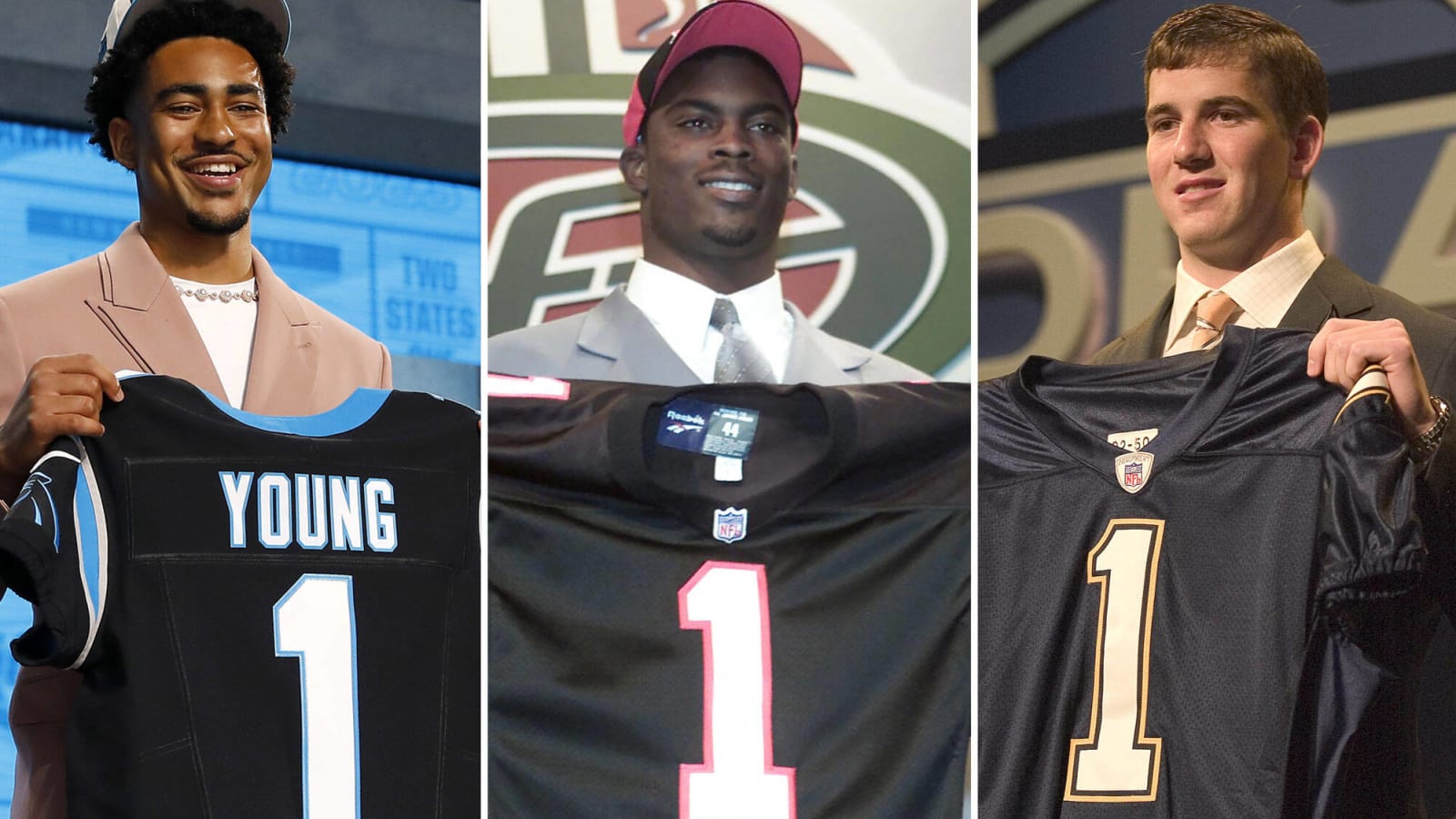
Every trade involving the No. 1 overall NFL draft pick
Teams use the NFL draft to make franchise-reshaping trades, whether for veteran players or to move up and down the board for college talent. This practice has gone on for more than 70 years. More than a dozen deals have involved the No. 1 overall pick in the NFL or AFL draft. Here are the trades that sent a team's first overall pick elsewhere.
2023: Bears allow Panthers to reboot around Bryce Young

Ex-Bears head coach Lovie Smith extended a figurative middle finger to the Texans in his final Houston game. It took a Texans Hail Mary and do-or-die two-point conversion to give the Bears the No. 1 pick. Despite Chicago's current regime not drafting Justin Fields, GM Ryan Poles made him the centerpiece of a bold trade. Since the draft moved to April in 1976, no team has traded a pick known to be No. 1 overall earlier than the Bears this year (March 10). Adrift at QB since Cam Newton's injuries mounted, the Panthers gave up D.J. Moore, a first-rounder and two seconds to move from No. 9 to No. 1. While Young is off to a slow start, the 5-foot-10 QB is the Panthers' new foundation.
2016: Jeff Fisher era winds down with Rams-Titans swap

Fisher's lengthy Titans run ended in 2011; five years later, the Rams called up his old team about the No. 1 pick. Moving to Los Angeles in 2016, the Rams snagged the draft's top QB prospect, doing so a year after trading 2010 No. 1 pick Sam Bradford. It cost the Rams a first-rounder, two seconds and three thirds to climb from No. 15 to No. 1. This haul probably would have been steeper had Goff's prospect profile been higher. The Titans had used the 2015 No. 2 pick on Marcus Mariota, driving the trade. Goff struggled as a rookie, leading to Fisher's firing, but took big steps under Sean McVay. The trade-happy Rams have not made a first-round pick since Goff.
2001: Chargers give up Michael Vick pick, land two legends

The Chargers began negotiating with Vick, but a CBA that allowed for considerable wiggle room led to a pre-draft standstill. The Bolts wanted to include contractual safeguards to prevent a Ryan Leaf redux, but Vick's camp was not into such a compromise. The conservative franchise dealt the No. 1 pick to the Falcons for a light haul: No. 5, a 2001 third-rounder, a 2002 second and speedy return man Tim Dwight. San Diego worked wonders with its top two picks. In came LaDainian Tomlinson at five and Drew Brees at 33. Vick displayed his electric skillset in Atlanta, but the 2007 dogfighting scandal tarnished his reputation. Tomlinson became a first-ballot Hall of Famer.
1997: Would-be Manning slot turns into Hall of Fame tackle

Perhaps the "what if?" in Jets history, Peyton Manning returned to Tennessee for his senior season. Rules at the time permitted Manning to hold off on that decision, and he kept the Jets in suspense until March. Rich Kotite's final year in charge (1996) involved big-ticket free agent tackle signings (Jumbo Elliott and David Williams), leading new honcho Bill Parcells to unload the No. 1 pick. The Rams only needed to send the Jets third- and fifth-round picks to climb from 5 to 1. Orlando Pace became St. Louis' foundational left tackle, later protecting Kurt Warner on two Super Bowl teams and cruising to the Hall of Fame. The Jets traded down again, to No. 8, and chose linebacker James Farrior.
1995: Bengals' climb for RB leads to bad break

The Bengals ended up making the top pick in 1994 (defensive lineman Dan Wilkinson) and '95. The Panthers won the expansion coin toss with the Jaguars, but Carolina traded the No. 1 pick to Cincinnati, which chose running back Ki-Jana Carter. This era did not place the kind of premium on the No. 1 pick that exists today, with the Bengals only tossing in a second-rounder to move up. Unfortunately for Cincy, the move backfired. Carter suffered an ACL tear before his rookie season and was never the same. The Panthers chose Carter's college QB, Kerry Collins, at 5. The Bengals have not traded up in the first round since.
1991: Ismail's windfall points Cowboys toward defense

Notre Dame star Rocket Ismail was on track to be 1991's top draftee, but an otherworldly offer -- an unprecedented $18.2 million guarantee -- from the CFL's Toronto Argonauts sent the wide receiver to Canada. Before Ismail's decision, the Patriots sent the Cowboys the No. 1 pick for Nos. 11 and 41, along with three veterans -- including 30-year-old linebacker Eugene Lockhart. Dallas had extra first-round capital thanks to the 1989 Herschel Walker heist. The Cowboys negotiated with Ismail and discussed dealing the pick to the Falcons, when the elder Ismail brother was still in play. But the Cowboys chose defensive tackle Russell Maryland, who started for each of their 1990s Super Bowl teams.
1990: Colts err with Jeff George trade-up

The Falcons did well in moving out of the No. 1 slot. Capitalizing on the Colts' interest in adding George -- a cannon-armed prospect out of Illinois -- the Falcons pried Pro Bowl tackle Chris Hinton, 1989 first-round pick Andre Rison and a 1991 first-rounder. Rison ripped off four straight seasons of double-digit TD receptions, becoming one of the 1990s' best receivers, and Hinton earned All-Pro acclaim in Atlanta. Both anchored a 1991 playoff team. George busted in Indianapolis, and the Colts traded the talented but notoriously difficult QB in 1994. This actually burned the Falcons, who sent two first-rounders -- one of those becoming Marvin Harrison -- and a third for the QB they once passed on.
1984: Pick's second trade sends Irving Fryar to Patriots

The second leg of the 1984 top pick's lifespan featured the Patriots and Bengals. And the USFL. The upstart league poached both of 1984's top two prospects -- Steve Young and Heisman-winning running back Mike Rozier -- to key a Bengals audible. Current Bengals owner Mike Brown, then the assistant GM, led negotiations with Young, extending a five-year, $3.5 million offer. That was considered undervalued, and the USFL's Los Angeles Express topped it rather easily by authorizing a sports-record deal. This led the Bengals to trade the pick to the Patriots, who chose Fryar, a wideout from Nebraska. Fryar was inconsistent in nine Pats seasons and did better work in his 30s elsewhere. The Bengals received first-, fifth- and 10th-round picks in the swap.
1984: Ill-fated Bucs QB deal sent Bengals top pick
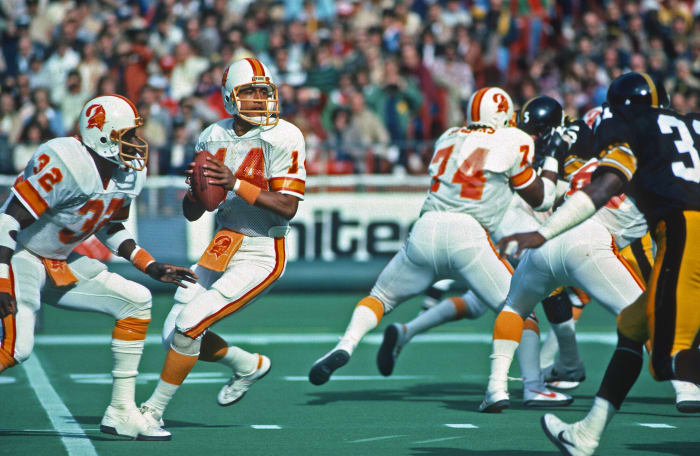
Before the Young-Fryar procession, the Bengals obtained the No. 1 pick in June 1983. Seeking a quarterback upgrade, the Buccaneers traded their 1984 first-rounder for Bengals backup Jack Thompson. The 1979 No. 3 overall pick, Thompson was viewed as the Ken Anderson heir apparent. But the accuracy maven held off the younger reserve's challenge, winning MVP honors in 1981 and another completion percentage title in 1982. Thompson made just five starts in four Bengals years, but the Bucs installed him as their QB1 for a 13-start '83 slate. The move backfired, and a 2-14 season gifted the Bengals the 1984 No. 1 choice.
1978: Oilers steal Earl Campbell from Buccaneers

The Bucs chose running back Ricky Bell first overall in 1977, and with the USC superstar entrenched, the team dealt the 1978 top choice. Campbell, who won the 1977 Heisman Trophy, was the prize. This trade also factored Campbell's contract requirements into the value, but it still skewed wildly in Houston's favor. To move up 16 spots in Round 1, the Oilers only sent the Bucs second-, third- and fifth-round picks, along with second-year tight end Jimmie Giles. While Giles became a Pro Bowler in Tampa, Campbell changed the Oilers' fortunes immediately. The bulldozing back was a top-two MVP finisher from 1978-80, winning the award in 1979, and stampeded to Canton.
1975: Falcons' Steve Bartkowski pickup first of its kind

From the first common draft in 1967 to the Falcons-Colts' Jeff George-centered move in 1990, only one team traded up to No. 1 for a quarterback. The same two franchises were involved here, with the Colts moving down two spots and acquiring perennial Pro Bowl right tackle George Kunz in the trade. The Colts had Bert Jones ready for a mid-1970s ascent, passing on Bartkowski, who became the Falcons' longest-tenured QB until Matt Ryan. A Cal alum, Bartkowski played 11 Atlanta seasons and piloted the team to its first three playoff berths. Kunz helped Jones lead Baltimore to three straight playoff berths from 1975-77, and the No. 3 pick became six-year guard starter Ken Huff.
1974: Intra-Texas swap swings wildly for Cowboys

The Oilers-Titans' franchise nadir occurred in the early 1970s; Houston went 2-26 from 1972-73. After their one-win 1972, the Oilers made a major misstep. They traded their 1974 first-round pick to the Cowboys in exchange for zero future draft picks; instead, third-year defensive end Tody Smith and fourth-year receiver Billy Parks comprised the haul. Dallas, which would later move up to No. 2 overall in 1975 (Randy White) and '77 (Tony Dorsett), took dynamic sack artist Ed "Too Tall" Jones. The 6-foot-9 standout played 15 seasons for the Cowboys, totaling 106 sacks. Smith, a 1971 first-round pick, played well for a short span in Houston. But both trade chips were gone by 1976.
1968: Unique clause sends Hall of Fame tackle to Vikings

Fran Tarkenton's Giants years are not as well remembered, but the first Vikings-Giants trade involving the Hall of Fame QB led to a one-of-a-kind draft quirk. When the AFL and NFL merged in 1967, the Giants received a strange credit, being granted the right to draft first overall -- regardless of record -- in either 1967 or '68. New York traded this odd clause to the Vikings upon acquiring Tarkenton in 1967. The Giants went 7-7 in 1967, but the pick they sent to Minnesota for Tarkenton landed first. The Vikes chose tackle Ron Yary, who became a seven-time All-Pro and started in each of Minnesota's four Super Bowls. Tarkenton spent five years in New York before being traded back to Minnesota in 1972.
1967: Future 'Police Academy' attendee heads to Baltimore

Ahead of their first season, the Saints sent their expansion-generated No. 1 pick to the Colts for Johnny Unitas backup Gary Cuozzo. The Saints threw in center Bill Curry, whom they added in the 1967 expansion draft. Cuozzo made 10 starts in one Saints season (before the Vikings sent a first-rounder for him). In this historic heist, the Colts landed dynamic D-lineman Bubba Smith at No. 1. Before a 1972 injury, Smith was a force in Baltimore. He anchored two Super Bowl-bound Colts pass rushes (and later served as a key sidekick in six Police Academy movies). A two-Super Bowl starter in Green Bay, Curry started in Super Bowls III and V. Both were multi-time Pro Bowlers in Baltimore.
1964: Patriots lose out in AFL-NFL bidding war
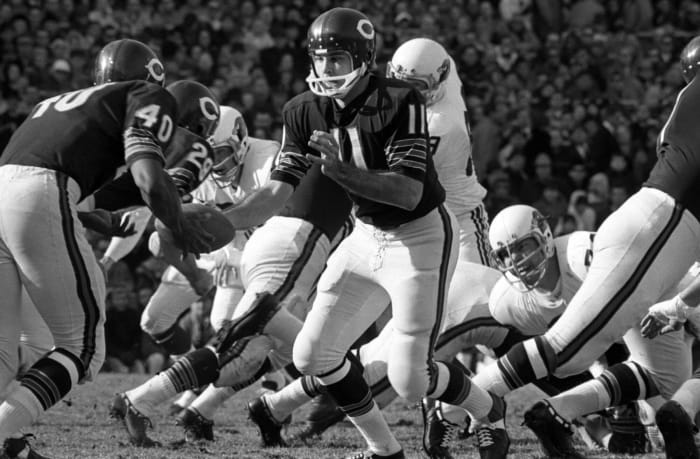
The mid-1960s AFL and NFL drafts may be the most interesting in NFL history, as they featured widespread competition for talent. The Patriots received a two-punch combination amid a 1964 battle. Boston traded up from No. 4 to No. 1 with Denver in the AFL's fourth college draft, and though this only cost a third-round pick, the prize here -- QB Jack Concannon, a Dorcester, Mass., native -- preferred the NFL offer he received. A low-level Patriots offer led to the Eagles taking a second-round flier in the NFL draft, which occurred two days later. Philly convinced the standout QB to leave Boston, leaving the Pats with nothing. A 45-game starter (mostly with the Bears), Concannon played 12 seasons.
1963: Raiders on wrong end of rivalry trade
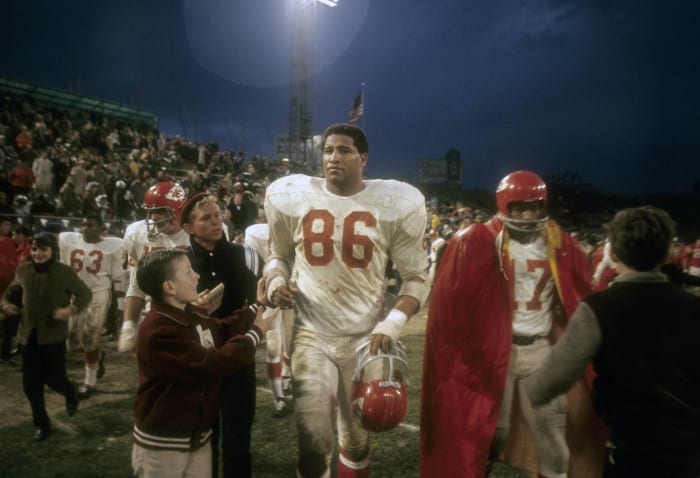
Months before morphing into the Chiefs, the Dallas Texans signed Len Dawson. Washing out in Pittsburgh and Cleveland, the future Hall of Famer replaced Cotton Davidson at the helm in Dallas. One game into Dawson's tenure, the Texans traded Davidson -- their starter from 1960-61 -- to the Raiders for a 1963 first-round pick. With the Raiders struggling in the early '60s, that selection became No. 1 overall in the eight-team draft. Shortly before rebranding, the Texans chose Grambling State dynamo Buck Buchanan. The dominant D-tackle became a mainstay on elite Kansas City defenses, zooming to the Hall of Fame after a 13-year career. Davidson played in Oakland for six seasons, mostly as a backup.
1941: Bears send out early trade test balloon
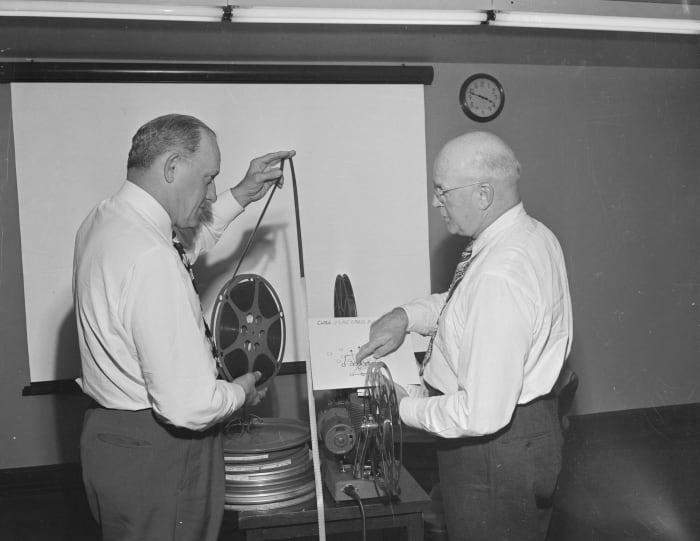
Held in 1940, the 1941 NFL Draft featured a trade between the Bears and Eagles. The Bears, who routed Washington in the most one-sided championship game in NFL history a day earlier (73-0), moved up to draft 1940 Heisman recipient Tom Harmon. The Michigan star, however, opted for a Columbia Pictures movie deal instead. Harmon later served in World War II, and once he returned, the Bears traded him to the Rams. While Harmon only played two NFL seasons, he accomplished a rare feat by scoring a touchdown in four varieties in 1947. Harmon found paydirt on the ground, through the air, on a pick-six and on a punt return.
Sam Robinson is a Kansas City, Mo.-based writer who mostly writes about the NFL. He has covered sports for nearly 10 years. Boxing, the Royals and Pandora stations featuring female rock protagonists are some of his go-tos. Occasionally interesting tweets @SRobinson25.
More must-reads:
- Latest CBS 2024 NFL mock draft doesn't foresee change at the top
- As Baker Mayfield struggles, Buccaneers pegged for Pac-12 QB in mock draft
- The 'Most career passing touchdowns' quiz
Breaking News
Customize Your Newsletter
 +
+
Get the latest news and rumors, customized to your favorite sports and teams. Emailed daily. Always free!
Use of this website (including any and all parts and
components) constitutes your acceptance of these
Terms of Service and Privacy Policy.

